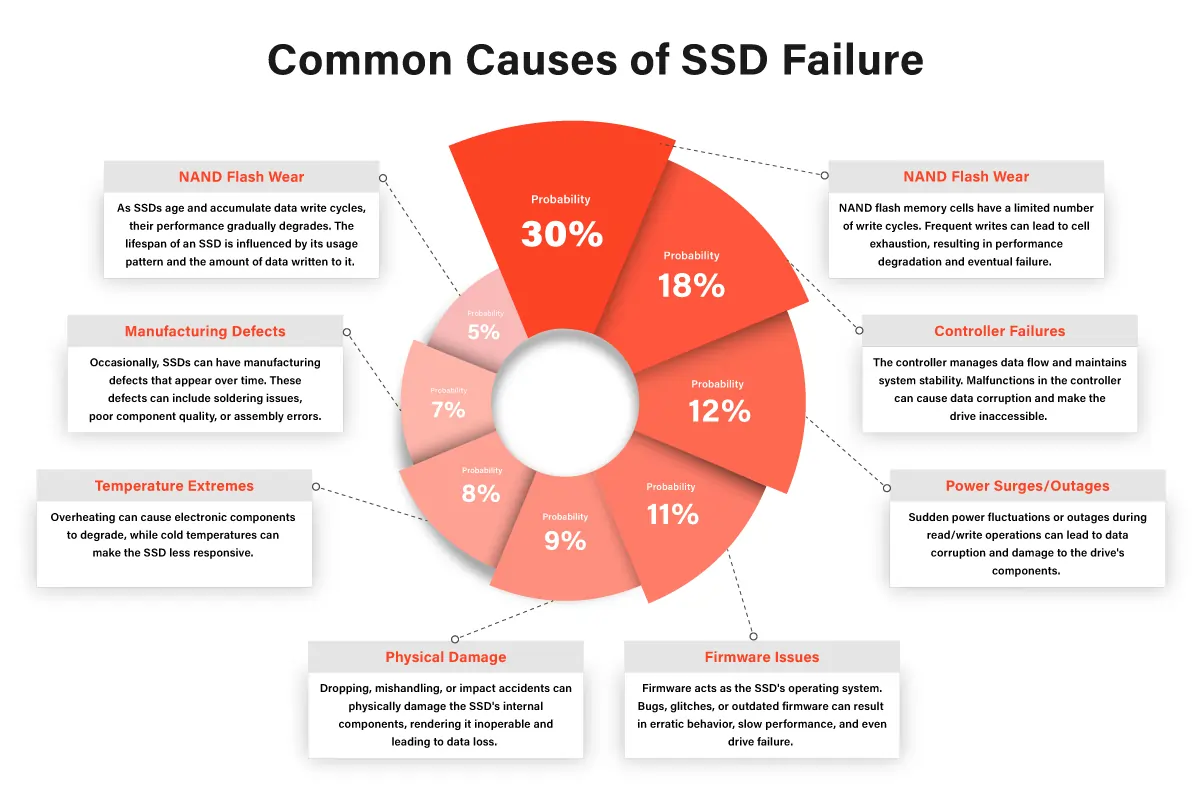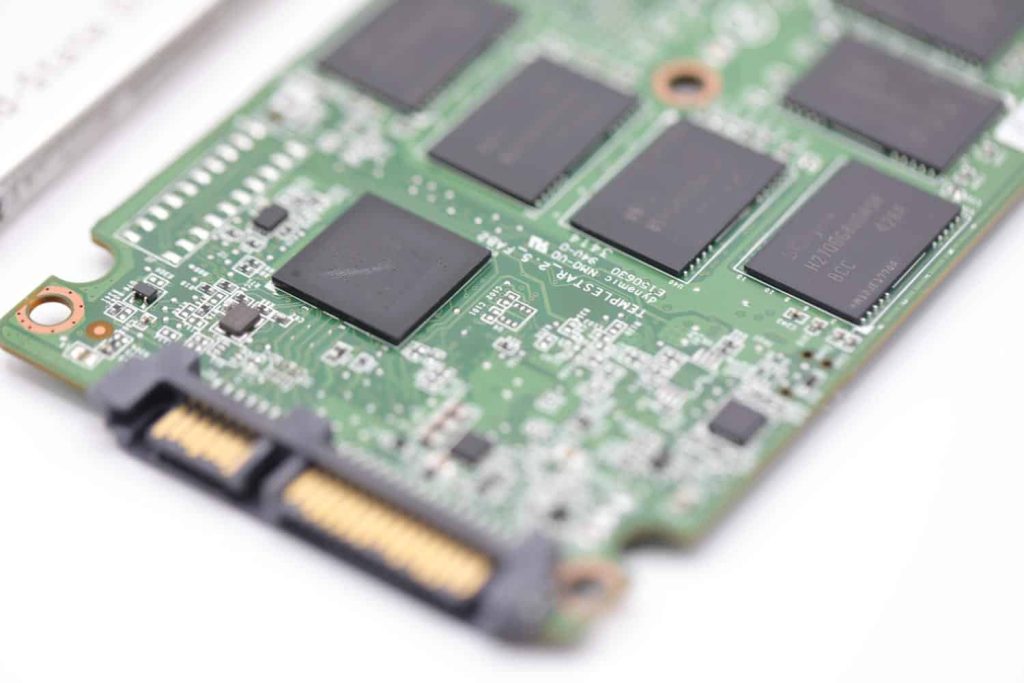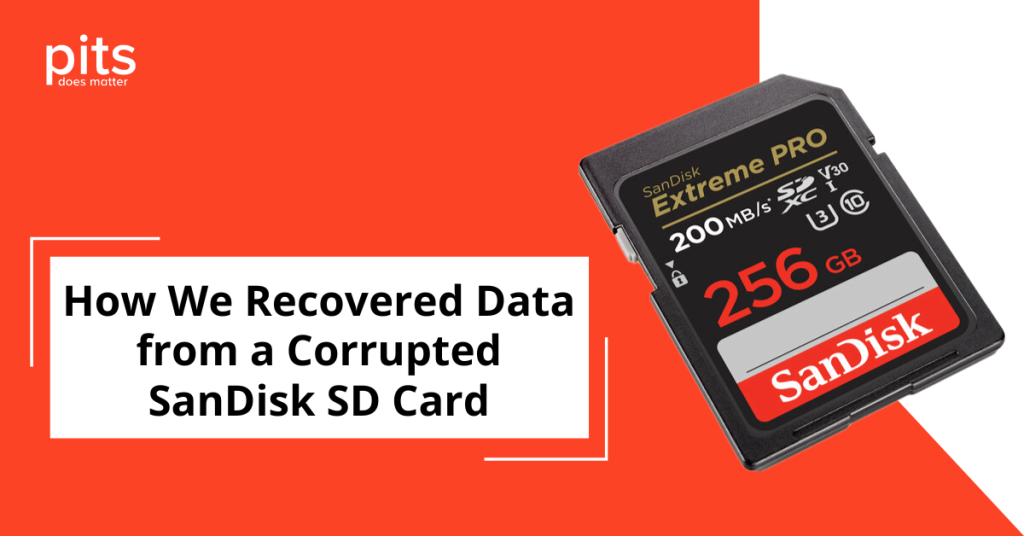In the advent of their introduction to the market, solid-state drives (SSDs) heralded a revolution in storage technology. The unparalleled swiftness and dependability exhibited by this apparatus remain unparalleled by alternative media.
A significant number of initial SSD adopters subscribed to the belief that these drives, bereft of moving components, would endure indefinitely. Consequently, solid-state drives are endowed with substantially diminished susceptibility to issues, malfunctions, and disruptions. Ergo, the paucity of components liable to malfunction inherently contributes to the heightened overall dependability of the device.
Are SSD Drives Prone to Malfunction?
Indeed, akin to any electronic mechanism, SSDs are susceptible to malfunction. Despite their recognized robustness and reliability, SSDs are not impervious to hardware breakdown, data degradation, and assorted predicaments that might impede their proper functioning.
Nonetheless, the probability of an SSD encountering failure remains comparatively modest when juxtaposed with conventional Hard Disk Drives (HDDs), which tend to be more predisposed to mechanical faults. Notwithstanding, it is of paramount importance to consistently monitor the well-being of your SSD, undertake essential maintenance duties, and establish data backups to preclude data loss in the event of SSD failure.
Factors Leading to SSD Failure
Physical Impairment: As previously highlighted, SSDs lack the moving components that render HDDs more susceptible to malfunction. However, physical impairment remains a potential issue capable of inducing device failure. On occasion, a physical defect may stem from manufacturer oversight. Furthermore, physical harm can emanate from sources such as water incursion, power disruption, or electrical surges. These triggers have the potential to inflict irreversible data loss upon the SSD.
SSD Longevity: Solid-state drives possess finite write cycles, delineating the quantum of data that can be inscribed onto the medium before it succumbs to deterioration. Consequently, when operating with an SSD, consistent scrutiny of memory status and frequent data backups become imperative. Such measures ensure that should the device falter due to wear and tear, the data contained therein remains safeguarded.
Data Degradation: Analogous to physical impairment, logical defects within solid-state drives manifest with comparable frequency. Data corruption constitutes a prominent example of a logical aberration.

Failure in Drive Firmware Upgrade: Periodically, it becomes imperative to enhance the firmware of a solid-state drive for the purpose of augmenting its operational efficiency. Vigilant oversight of the complete update procedure is of paramount importance. In instances where the progression is impeded or encounters complications, the SSD is prone to failure. This failure manifests as an immediate cessation of functionality, thereby rendering the files within the device inaccessible.
Identifying Impending SSD Failure - A Comprehensive Guide
Vigilant detection of preliminary warning signals stands as a pivotal measure to avert significant data loss attributed to a failing Solid State Drive (SSD). There exists a range of indicators that may suggest an SSD’s impending failure.
A prevalent indication resides in abrupt system crashes or freezes, typified by instances where the SSD faces challenges in accurately reading or writing data. Another telltale sign manifests in the form of recurrent blue screen errors, which transpire when the operating system confronts critical anomalies capable of inducing data corruption. Laggard boot times and unresponsive applications similarly serve as markers of an SSD teetering toward a malfunction.
Routine monitoring of your SSD’s well-being emerges as a necessity to promptly intercept potential issues. One effective approach is to undertake a SMART (Self-Monitoring, Analysis, and Reporting Technology) assessment, offering an overarching appraisal of the drive’s holistic health and operational prowess.
Furthermore, diligent observation of the SSD’s temperature and write cycles can furnish insight into potential impending failure. Most SSD manufacturers furnish diagnostic utilities, facilitating the evaluation of your SSD’s health.
In light of these considerations, maintaining regular backups of your pivotal data assumes critical importance, particularly when suspicions arise regarding the possible deterioration of your SSD.
Navigating SSD Failure - Recommended Course of Action
The occurrence of a solid-state drive failure constitutes an unforeseen incident that culminates in the unavailability of all invaluable data stored within. In response, users invariably seek expedient and accessible avenues to recover vital files. Frequently, the quest leads them to explore potential recovery methods in the online domain. However, it is imperative to underscore that embarking upon rectification endeavors devoid of the guidance of a qualified expert can potentially exacerbate the situation.

Numerous data recovery applications purport to reinstate all lost files, yet conversely, their operation might inadvertently overwrite the very data they aim to salvage, rendering it irretrievable.
Furthermore, the utilization of an unverified data recovery application on the system carries the inherent risk of introducing viruses, thereby further complicating the data recovery process.
The prudent course of action does not advocate for self-attempts to rectify the solid-state drive issue. Instead, it is advisable to place one’s trust in a reputable data recovery enterprise. Several immediate steps necessitate the attention of the user subsequent to the incidence of failure.
When confronted with challenges involving solid-state drives, the initial measure entails powering down the device and disconnecting it from its power source. Subsequently, the search for a qualified recovery establishment adept in SSD recovery services and boasting a commendable success track record becomes imperative. Collaborating with adept engineers substantially enhances the likelihood of successfully salvaging critical data.
Retrieve Data from a Failing SSD
PITS Global Data Recovery Services stands as a reputable and esteemed purveyor of solutions dedicated to repairing SSD data. Our team of engineers specializes in the realm of solid-state drive recovery and is adept at reinstating files from a diverse spectrum of types, brands, operating systems, and file systems.
Backed by a substantial expanse of experience within the domain of data recovery, we proficiently salvage data from SSDs that have encountered failure, corruption or have become unresponsive, attaining optimal outcomes. Our panel of experts initiates the recovery procedure with a bespoke assessment, discerning the causative factors behind data loss and evaluating the extent of resultant damage.
Reasons to Engage Our Services for SSD File Recovery:
24/7 Emergency Service Availability
So if you're facing a data loss situation, don't hesitate to contact us. Our 24/7 data recovery services are available 365 days a year. Let us help you recover your precious data today.
Certified Data Recovery Laboratories
So if you're facing a data loss situation, look no further. With our certified data recovery labs and 99% success rate, we are confident that we can recover your precious data and get you back on track.
Data Recovery Services Worldwide
PITS is a leading global recovery service provider specializing in retrieving data from various storage devices. With a widespread network of locations, we offer reliable solutions to clients worldwide.
ISO Certified Class 10 Cleanroom
Our engineers work in a controlled environment to ensure the safety of your device. We recover data in ISO Certified Class 10 Cleanroom and achieve high results.
Risk-free Evaluation and Assessment
We start the process with a risk-free evaluation. Our technicians estimate the reasons for data loss and the level of damage. We select the most suitable strategy.
100% Customer Satisfaction Rate
With years in the data recovery industry, our company supports the highest customer satisfaction rate. We do everything to provide a positive experience for our clients.
Operating within an ISO Certified Class 10 Cleanroom environment, we execute the secure and professional retrieval of lost data from solid-state drives. Commence your SSD data recovery journey in collaboration with PITS Global Data Recovery Services by contacting our dedicated customer service line. Alternatively, you may establish contact by completing the “Request Help” form provided below. Irrespective of the circumstances leading to SSD failure and data loss, we are steadfastly committed to employing our utmost endeavors to effectuate data recovery from your solid-state drive.
Frequently Asked Questions
What is an SSD?
SSD stands for Solid-State Drive. It is a type of storage device that uses flash memory to store data. Unlike traditional hard disk drives (HDDs) that use spinning disks, SSDs have no moving parts, which makes them faster, more reliable, and more durable.
What are the common causes of SSD failure?
- NAND Flash Wear: SSDs use NAND flash memory cells to store data. These cells have a limited lifespan, and over time, they can wear out due to excessive read/write operations, leading to data loss or drive failure.
- Power Surges or Electrical Issues: Sudden power surges or electrical fluctuations can cause damage to the electronic components of an SSD, resulting in failure.
- Firmware Issues: Firmware is the software embedded in the SSD that controls its operations. If the firmware becomes corrupted or outdated, it can lead to drive failure or data corruption.
- Overheating: SSDs generate heat during operation, and excessive heat can degrade their performance and lifespan. Poor ventilation or inadequate cooling can lead to overheating and eventual failure.
- Physical Damage: Dropping or mishandling an SSD can cause physical damage to its internal components, rendering it unusable.
Manufacturing Defects: In rare cases, SSDs can fail due to manufacturing defects or faulty components. These defects may manifest as sudden failures or intermittent issues.
How can I prevent SSD failure?
- Avoid Excessive Read/Write Operations: SSDs have a limited lifespan, so minimizing unnecessary read/write operations can help prolong their life. Regularly backing up data and avoiding constant large file transfers can be beneficial.
- Use an Uninterruptible Power Supply (UPS): Using a UPS can protect your SSD from sudden power surges or outages, minimizing the risk of electrical damage.
- Keep SSDs Cool: Ensure that your SSD is adequately cooled to prevent overheating. Maintain proper ventilation in your computer case and consider using additional cooling solutions if necessary.
- Keep Firmware Updated: Check for firmware updates from the SSD manufacturer and apply them when available. Updated firmware often includes bug fixes, performance improvements, and enhanced compatibility.
Handle SSDs with Care: Avoid dropping or mishandling your SSD. When installing or removing it from your computer, follow proper procedures and use appropriate tools.
Can data recovery be possible if an SSD fails?
Data recovery from a failed SSD can be challenging and often requires professional assistance. Unlike HDDs, SSDs store data in a complex way that involves wear leveling and data remapping, making it difficult to retrieve data directly. In some cases, specialized data recovery techniques may be able to retrieve a portion of the data, but success cannot be guaranteed.
Is it worth using SSDs despite the possibility of failure?
Despite the potential for failure, SSDs are still worth using due to their numerous advantages over traditional HDDs. SSDs offer faster performance, improved durability, and lower power consumption. The majority of SSDs function reliably throughout their lifespan, and failures are relatively rare. Regular backups and following best practices can help mitigate the impact of a potential failure.
We’re Here to Help
Our experienced team is committed to helping you recover your critical data. No matter the situation, we work diligently to ensure the best possible outcome. Take action now and let us restore what’s important to you.
Start Recovery Process
"*" indicates required fields


